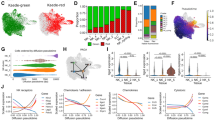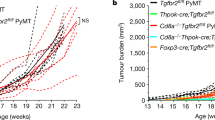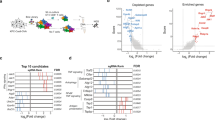Abstract
The apoptosis-inducing Fas receptor has been shown to be down-regulated in various types of tumors, while its ligand (FasL) appears to be frequently up-regulated. Here we provide evidence that there is a strong selective pressure in vivo against Fas-expressing, tumorigenic NIH3T3 cells, favoring survival, proliferation and eventually tumor formation by Fas-negative cells. Importantly, re-expression of Fas in these cells results in either the complete abolishment of tumor development, or in a significant extenuation of the latency period of tumor outgrowth. In addition, we found that environmental conditions which prevail during tumorigenesis, such as limiting amounts of survival factors and the lack of cell adhesion, are markedly sensitizing tumor cells to Fas-mediated suicide. Our data suggest that in addition to T cell-mediated immune responses, mechanisms of Fas-dependent tissue turnover are also centrally implicated in tumor cell clearance.
This is a preview of subscription content, access via your institution
Access options
Subscribe to this journal
Receive 50 print issues and online access
$259.00 per year
only $5.18 per issue
Buy this article
- Purchase on Springer Link
- Instant access to full article PDF
Prices may be subject to local taxes which are calculated during checkout





Similar content being viewed by others
References
Abbas AK . 1996 Cell 84: 655–657
Butler LM, Hewett PJ, Butler WJ and Cowled PA . 1998 Br J Cancer 77: 1454–1459
Deveraux QL, Roy N, Stennicke HR, Van Arsdale T, Zhou Q, Srinivasula SM, Alnemri ES, Salvesen GS and Reed JC . 1998 EMBO J 17: 2215–2223
Djerbi M, Screpanti V, Catrina AI, Bogen B, Biberfeld P and Grandien A . 1999 J Exp Med 190: 1025–1031
Faris M, Kokot N, Latinis K, Kasibhatla S, Green DR, Koretzky GA and Nel A . 1998 J Immunol 160: 134–144
French LE, Hahne M, Viard I, Radlgruber G, Zanone R, Becker K, Muller C and Tschopp J . 1996 J Cell Biol 133: 335–343
Frisch SM and Francis H . 1994 J Cell Biol 124: 619–626
Hahne M, Rimoldi D, Schroter M, Romero P, Schreier M, French LE, Schneider P, Bornand T, Fontana A, Lienard D, Cerottini J and Tschopp J . 1996 Science 274: 1363–1366
Hill LI, Ouhtit A, Loughlin SM, Kripke ML, Ananthaswamy HN and Owen-Schaub LB . 1999 Science 285: 898–900
Hueber AO, Zornig M, Lyon D, Suda T, Nagata S and Evan GI . 1997 Science 278: 1305–1309
Irmler M, Thorne M, Hahne M, Schneider P, Hofmann K, Steiner V, Bodmer JI, Schroter M, Burns K, Mattmann C, Rimoldi D, French LE and Tschopp J . 1997 Nature 388: 190–195
Lebel M, Bertrand R and Mes-Masson AM . 1996 Oncogene 12: 1127–1135
Medema JP, de Jong J, van Hall T, Melief CJM and Offringa R . 1999 J Exp Med 190: 1033–1038
Moller P, Koretz K, Leithauser F, Bruderlein S, Henne C, Quentmeier A and Krammer PH . 1994 J Cancer 57: 371–377
Nagata S . 1997 Cell 88: 355–365
Nagata S and Golstein P . 1995 Science 267: 1449–1456
Peli J, Schroter M, Rudaz C, Hahne M, Meyer C, Reichmann E and Tschopp J . 1999 EMBO J 18: 1824–1831
Robertson MJ, Manley TJ, Pichert C, Cameron C, Cochran KJ, Levine H and Ritz J . 1995 Leuk Lymph 17: 51–61
Shinoura N, Yoshida Y, Nishimura M, Muramatsu Y, Asai A, Kirino T and Hamada H . 1999 Cancer Res 59: 4119–4128
Srivastava RK, Sasaki CY, Hardwick JM and Longo DI . 1999 J Exp Med 190: 253–265
Strand S, Hofmann WJ, Hug H, Muller M, Otto G, Strand D, Mariani SM, Stremmel W, Krammer PH and Galle PR . 1996 Nature Med 2: 1361–1366
Suzuki A, Enari M, Eguchi Y, Matsuzawa A, Nagata S, Tsujimoto Y and Iguchi T . 1996 EMBO J 15: 211–215
Thompson CB . 1995 Science 267: 1456–1462
Ungefroren H, Voss M, Jansen M, Roeder C, Henne-Bruns D, Kremer B and Kalthoff H . 1998 Cancer Res 58: 1741–1749
Walker PR, Saas P and Dietrich PY . 1997 J Immunol 158: 4521–4524
Wang CY, Mayo MW, Korneluk RG, Goeddel DV and Baldwin ASJ . 1998 Science 281: 1680–1683
Watanabe-Fukunaga R, Brannan CI, Copeland NG, Jenkins NA and Nagata S . 1992 Nature 356: 314–317
Acknowledgements
We thank Drs R Iggo, R Budds, A Quest and C Ware for helpful comments. This research was supported by the Swiss National Science Foundation (E Reichmann) and the Krebsforschung Schweiz (J Peli and E Reichmann).
Author information
Authors and Affiliations
Rights and permissions
About this article
Cite this article
Schröter, M., Peli, J., Hahne, M. et al. Fas-dependent tissue turnover is implicated in tumor cell clearance. Oncogene 19, 1794–1800 (2000). https://doi.org/10.1038/sj.onc.1203499
Received:
Revised:
Accepted:
Published:
Issue Date:
DOI: https://doi.org/10.1038/sj.onc.1203499



